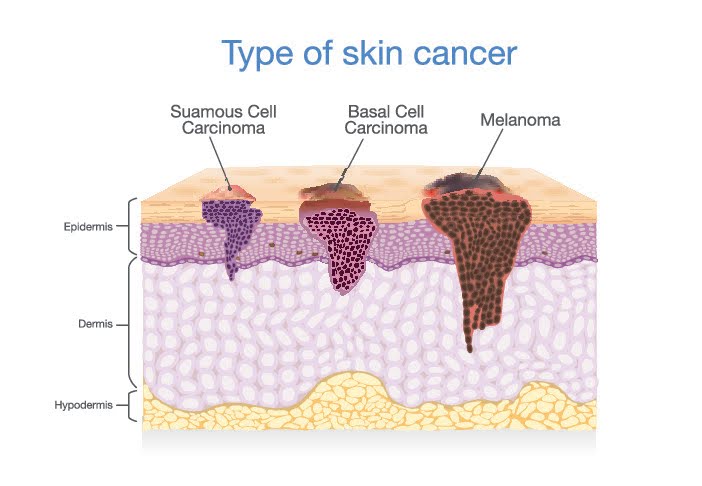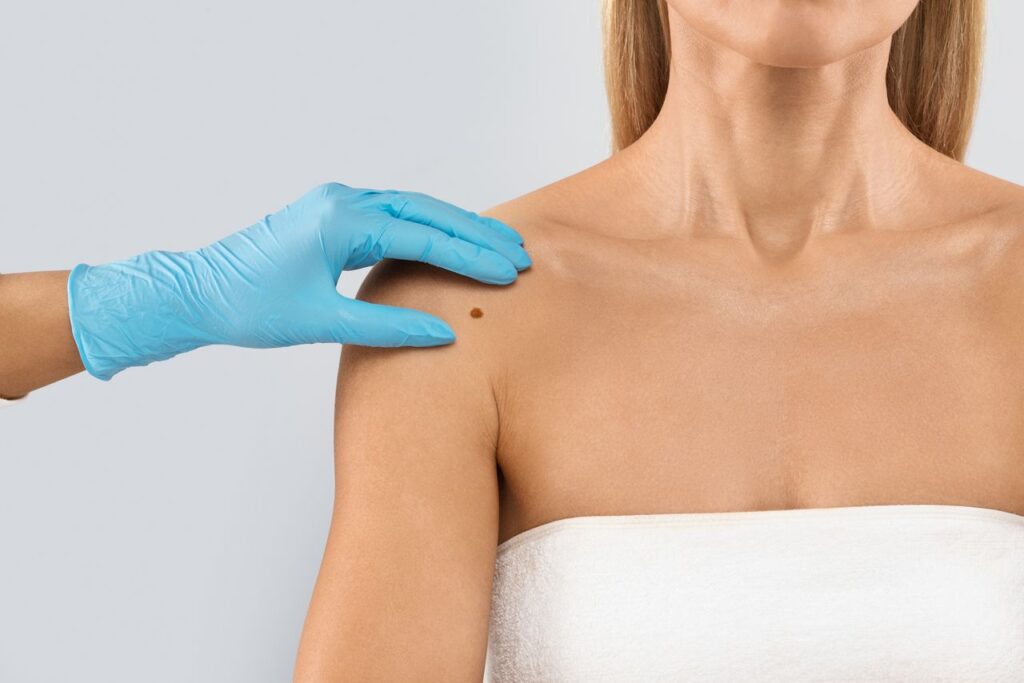What Does Skin Cancer Look Like?
- The Reality Check: Why Knowing Matters
- The Big Three: Types of Skin Cancer and What to Watch For
- What Causes Skin Cancer? The Sun (and More)
- How Fast Does Skin Cancer Grow? It’s Complicated
- Your Action Plan: What to Do If You Spot Something Suspicious
- The Juniper Advantage: Advanced Detection and Treatment
Let’s have an honest conversation about something that affects more than 5 million Americans every year: skin cancer. If you’ve ever stood in front of a mirror examining a new mole or wondering if that spot on your arm looks different than it did last month, you’re already doing something incredibly important: paying attention to your skin.
We know that thinking about skin cancer can feel overwhelming, but here’s the thing: knowledge is power. The more you understand what to look for, the better equipped you’ll be to catch potential issues early when treatment is most effective. So let’s walk through this together, shall we?
The Reality Check: Why Knowing Matters
Skin cancer is the most common type of cancer in the United States, but here’s the encouraging news: it’s also one of the most treatable when caught early. The keyword here is “early.” That’s why learning to recognize the warning signs isn’t just helpful – it could be life-saving.
Think of yourself as the first line of defense for your own health. You see your skin every day, which means you’re in the best position to notice when something changes. Your dermatologist is your expert partner in this, but you’re the one who can spot the day-to-day differences that might signal it’s time for a professional evaluation.
The Big Three: Types of Skin Cancer and What to Watch For
Not all skin cancers look the same, and that’s partly what makes them tricky to identify. Let’s break down the three main types you should know about:

What Does Basal Cell Carcinoma Look Like?
Basal cell carcinoma is the most common type of skin cancer, and thankfully, it’s also typically the least aggressive. But what does it actually look like? Well, it depends – and we know that’s probably not the definitive answer you were hoping for!
Basal cell carcinoma can appear as a pearly or waxy bump, often with visible blood vessels running through it. Sometimes it looks like a flat, flesh-colored or brown scar-like lesion. It might also present as a bleeding or scabbing sore that heals and returns. These typically show up on sun-exposed areas like your face, ears, neck, scalp, shoulders, and back.
The tricky thing about basal cell carcinoma is that it can be quite subtle at first. You might notice a small bump that you initially dismiss as a pimple or minor skin irritation. The difference is that, unlike a temporary blemish, basal cell carcinoma doesn’t go away on its own.
What Does Squamous Cell Carcinoma Look Like?
Squamous cell carcinoma is the second most common type of skin cancer. Again, its appearance can vary, but there are some common characteristics to watch for.
This type often appears as a firm, red nodule or a flat lesion with a scaly, crusted surface. It might look like a persistent rough patch of skin, an open sore that doesn’t heal, or a raised growth with a central depression. Like basal cell carcinoma, squamous cell carcinoma typically develops in sun-exposed areas.
One thing that sets squamous cell carcinoma apart is that it can sometimes be tender to the touch or even painful. If you have a spot that’s been bothering you – whether it’s itchy, painful, or just feels different – it’s worth having it checked.
What Does Melanoma Look Like?
Now we come to melanoma, which is less common than the other two types but potentially more serious. The good news? When caught early, melanoma is highly treatable.
Melanoma can develop in an existing mole or appear as a new dark spot on your skin. This is where the famous “ABCDE” rule comes in handy:

But here’s what’s important to remember: melanoma doesn’t always follow these rules. It can be small, symmetrical, or even lack color entirely (amelanotic melanoma). This is why any new, changing, or unusual spot deserves professional attention.
What Causes Skin Cancer? The Sun (and More)
Let’s talk about the elephant in the room: sun damage. The primary cause of skin cancer is ultraviolet (UV) radiation from the sun and tanning beds. Those UV rays damage the DNA in your skin cells, and over time, this damage can lead to cancer.
But sun exposure isn’t the only factor. There are some genetic components at play as well. If you have a family history of skin cancer, fair skin that burns easily, a history of sunburns (especially blistering ones), or many moles, your risk may be higher.
Other factors include having a weakened immune system, exposure to certain chemicals, and previous radiation treatment. The good news is that while you can’t change your genetics, you can absolutely take steps to protect yourself from further UV damage.
How Fast Does Skin Cancer Grow? It’s Complicated
This is one of those questions where the answer really is “it depends.” The growth rate of skin cancer varies significantly based on the type and the individual.
Basal cell carcinomas typically grow slowly, sometimes taking months or even years to become noticeable. Squamous cell carcinomas can grow more quickly than basal cell carcinomas but are still generally slower-growing than melanomas.
Melanoma can be unpredictable. Some melanomas grow slowly over months or years, while others can change rapidly over weeks. This variability is part of what makes melanoma potentially more dangerous and why any changing spot should be evaluated promptly.
The key takeaway? Don’t wait to see how fast something grows. If you notice any new or changing spots on your skin, it’s better to have them checked sooner rather than later.
Your Action Plan: What to Do If You Spot Something Suspicious
First, don’t panic. Finding a suspicious spot doesn’t automatically mean you have skin cancer. Many skin changes are benign, but the only way to know for sure is through professional evaluation.
Here’s what you should do:
Schedule a skin cancer screening with a dermatologist as soon as possible. At Juniper Dermatology, we offer comprehensive skin cancer screenings where we examine your entire body for any concerning spots.
Document what you’ve noticed. Take a photo if possible, and note when you first noticed the spot and any changes you’ve observed. This information can be helpful for your dermatologist.
Don’t try to self-diagnose. While it’s great to be aware of what to look for, remember that even dermatologists often need to perform biopsies to definitively diagnose skin cancer.
The Juniper Advantage: Advanced Detection and Treatment
At Juniper Dermatology, we’re committed to providing you with the most advanced care available. Our approach to melanoma and skin cancer treatment combines cutting-edge technology with compassionate, personalized care.
For certain types of skin cancer, we offer innovative treatment options like GentleCure, a revolutionary non-surgical treatment that’s particularly effective for basal cell and squamous cell carcinomas, as well as other recurrent skin cancers. GentleCure uses image-guided superficial radiotherapy to target cancer cells while preserving healthy tissue – and it’s typically not used for melanoma, which usually requires different treatment approaches.
For high-risk skin cancers that require the most precise surgical approach, we also coordinate Mohs surgery referrals. While we don’t perform Mohs surgery in our office, we work closely with specialized Mohs surgeons to ensure you receive this highly effective treatment when it’s the best option for your specific case. Mohs surgery offers the highest cure rates for certain skin cancers by removing the cancer layer by layer while preserving as much healthy tissue as possible.
What sets us apart is our commitment to early detection and comprehensive care. We believe that the best treatment is often prevention and early intervention. That’s why we encourage regular skin screenings and provide you with the education you need to be an active participant in your skin health.
Remember, your skin tells a story, and we’re here to help you understand what it’s saying. Whether you’re coming in for a routine screening or you’ve noticed something that concerns you, we’re here to provide answers, peace of mind, and if needed, the most effective treatment options available.
Don’t let worry about skin cancer keep you up at night. Instead, let knowledge empower you to take action. Your skin – and your peace of mind – will thank you for it.
For more resources on skin cancer, visit this page from the American Academy of Dermatologists.


